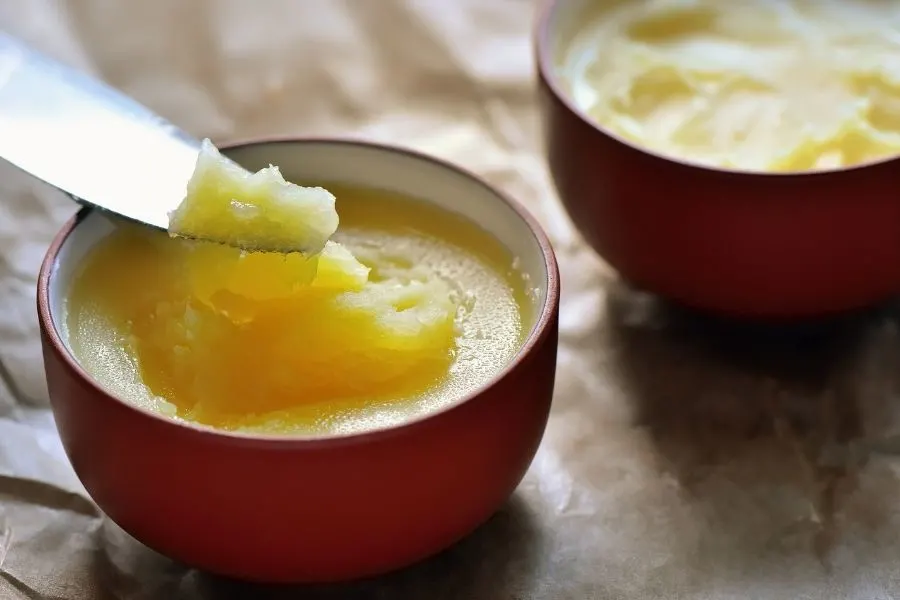Butter has this amazing ability to make everything that much better tasting, and it makes for a delicious smell, too ! One thing you always have to remember though, is to take the butter out of the fridge so it softens enough. Even so, room temperature butter is more solid than you’d initially think.
But why is butter solid at room temperature ? And why is it solid yet spreadable ? Why does it harden so much in the fridge ? Is there any way to make your own soft butter spread ? All this and more, coming right up.

Why is butter solid at room temperature ?
Butter remains solid at room temperature because it is saturated fat. This means that the fat molecules have a straight carbon center, surrounded by hydrogen atoms. They resemble short sticks under a microscope, and this shape allows them to stack neatly, forming a solid mass.
One thing that definitely helps: the milk solids (proteins) in butter help it thicken even more.
Coconut butter, cocoa butter, shea butter, lard, all have similar structures and thus will always be solid at room temperature. They start to melt when exposed to warmer temperatures (like skin).
Saturated and unsaturated fats explained
You may be wondering why it matters if a fat is saturated or not. For the purpose of texture and structure, it matters a lot because it dictates whether the fat will remain liquid or solidify at room temperature.
Saturated fats have the straight, stackable shape we talked about earlier. Unsaturated fats are not completely straight, they have a bit of a bend, so they cannot stack neatly on top of each other.
Read also: Why Is Olive Oil So Expensive ?
When exposed to high temperatures, saturated fats lose that perfectly neat shape, and they become liquid. Sometimes human skin temperature is all it takes.
In short, saturated and unsaturated fats simply have different solidifying points. This is a key element in judging whether something can be considered a butter, or an oil.
Does ghee solidify ?
Yes, ghee can solidify if kept in the fridge. Ghee is simply clarified butter, or butter that’s been browned and has the milk solids removed. This raises it smoke point (nothing left to easily burn), and brings a nice nutty, delicious flavor.
At room temperature ghee is closer to lard in terms of texture. It’s vaguely solid, but very spreadable and malleable.

Can you leave butter on the counter ?
You can leave butter on the counter for up to 48 hours in a room that is not hot (under 25 C/77 F). As long as the butter is covered by a dish, to keep it away from direct sunlight and any dust motes, it should be safe to eat.
Do not keep it out more than 48 hours, because it can quickly turn rancid if left at room temperature too long. Conversely, never leave the whole stick of butter out, unless you and your family use up an entire stick in one day.
If your butter intake is like most people, then a third of a stick kept in a butter dish on the counter should be fine. The rest will be in the fridge. This way you can cut another piece and leave that in the dish for later, without the whole stick going bad.
Make your own soft butter spread
The whole point of leaving butter on the counter is to keep it at room temperature so it’s easily spreadable. This is very convenient, but like we discussed before, it can quickly go bad.
So if you don’t want to keep a small amount out, you can try another option. You can make your very own soft, spreadable butter ! The best part is, you can make this out of anything you like, you have full control over what goes into this.
You will need:
- 1/2 unsalted butter, room temperature*
- 1/2 vegetable oil of your choosing*
- a mixer or spatula to mix with
- bowl
- container to keep the spread in, make sure it has a lid
- any flavorings you want, if any
*The amount and ratio of butter and oil is what makes the whole thing spreadable. The butter is the base and flavor, the oil is there to thin it out a little and provide a looser, spreadable texture. More butter=thicker spread. More oil=looser spread. This is why it’s a 1:1 ratio, but you can easily change it to your liking.
How to make the butter spread
Now let’s get to making this. First, make sure your butter is room temperature, it cannot be hard, it must be soft (not microwaved). You need to mix and mash the soft butter in the bowl, and get it to a somewhat fluffy consistency. Don’t mix it too hard, we need to slowly add the oil in.

Once the butter is broken down into a sort of creamy mess, slowly add in butter, a little at a time like making mayo. Make sure your mixer is on low for this. Keep mixing until the oil is incorporated, and add more as you go. This whole thing can take a few minutes.
At the end, you should have a butter that is soft, easily scooped with a butter knife. Turn everything into the container you chose, put the lid on, and keep it in the fridge. After a couple of hours, check on it. If it’s easily spreadable – like shortening or margarine – it’s good to go.
If it ended up too soft, try a 1:1.5 ratio of oil to butter next. If it’s too hard, try adding more oil next. As for the flavors, you can use whatever you want, or just add salt, or don’t add anything at all.
So there are a few ways to get around how hard butter can be, and you don’t always have to keep it on the counter.

